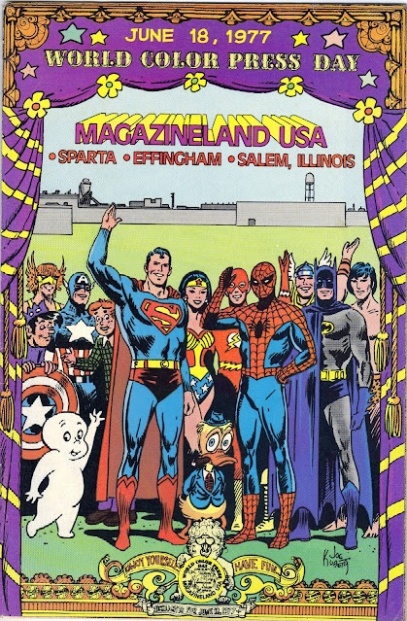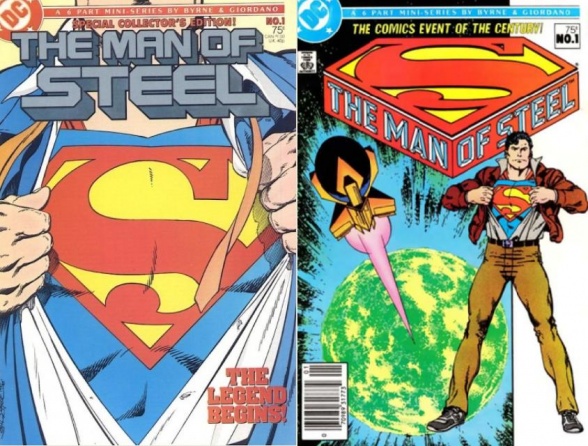Multiversity’s history column returns with three all-new, all-different items from the annals of the comic industry. Today you’ll learn about the rise of World Color Press, the history behind the “Man of Steel,” and the lost potential of a retail giant uninterested in selling comics.

Since its founding in St. Louis, Missouri in 1903, World Color Press was a printer who main product was color comic pages for newspapers. The company grew over the years through acquisitions and expanding their product line to include magazines and comic books. Business was good, and when the print industry boomed following the end of the World War II paper rationing, they needed to expand their production capabilities. On June 18, 1948, the company opened the doors to its new, top-of-the-line factory in Sparta, Illinois. It was the largest comic book factory in the world with peak employment around 1800 people.
Although the new printing presses allowed World Color to offer publishers a better product, a key element to the company’s success was in their shipping department. Their competitors would print a magazine, divide the run according to distributor orders, then ship the new issue to the distributors. World Color’s process was effectively the same, but their innovation was to combine shipping orders from different publishers. Instead of the factory sending a distributor eight boxes from eight publishers, they sent one box with material from eight publishers. This made life easier on distributors, and the publishers saw a reduced shipping charge on their order.
In the comic business, where profit margins were measured in pennies per unit, publishers couldn’t afford to overlook any cost savings advantage. Within five years, World Color Press was the exclusive printer for almost every comic company in the United States. The only significant holdout was Western/Gold Key, who resisted because they felt World Color’s quality was below their standards. Since Western was printing their own comics , it’s also true that switching to World Color would probably result in layoffs.
The centralized production meant World Color Press could affect the entire industry. In 1956, the factory installed a faster, cheaper web-offset press. Comic publishers couldn’t resist those upsides, but artists had to deal with the downside: the new press was terrible at reproducing fine lines. There was a learning curve, but they adapted their styles and began using bolder lines. Contemporary readers likely noticed the changes as quality took a dip, then rose again with a little less detail in the illustrations.
On the other hand, centralized production made the direct market of comic specialty shops possible in the late 1970s. The pool shipping offered by World Color meant Phil Seuling’s SeaGate distribution was a feasible business because all he and Jonni Levas had to do was submit orders, and World Color would handle the hard part of collating the comics for shipping to retail outlets. There’s a lot more to this story, and I’ll get around to sharing it with you one of these days.

To celebrate the 29th anniversary of the opening of the World Color Press plant in Sparta, Illinois, the company created a 16-page giveaway comic to show readers how comics are made. The story, which went into some real technical detail, can be read in it’s entirety here. It stands out for its presentation of popular characters from all the major publishers working together, making it a one-of-a-kind artifact, unlikely to ever be duplicated (much like Bugs Bunny meeting Mickey Mouse in Who Framed Roger Rabbit?). It was also illustrated by the rock-solid Joe Kubert.
World Color’s hegemony over comic publishing lasted until 1982, when Marvel and DC had to go with the Canadian company Ronald’s Printing for its special comics requiring the highest possible production values.

One of the goals of “Crisis on Infinite Earths,” DC’s first universe-redefining event, was to get rid of the various continuity snarls that had snuck into the stories over the decades. Writer Marv Wolfman wanted to wipe everything away and start with a clean slate – #1s across the board. That idea was dismissed as too radical, and something that could drive away long-term readers. Instead, they decided to continue with the existing numbering system, but present revised origins for characters after “Crisis” ended. The first character to get that treatment was Superman, naturally.Continued below
John Byrne, the writer-artist who had been complaining loudly for years that DC didn’t know what to do with Superman, was asked by Dick Giordano to submit a proposal. Byrne was under contract to Marvel at the time, but unhappy and willing to break it. He wrote down 20 items that he felt needed to be changed, and DC readily agreed to 19 of them. The one they rejected was for Superman’s pregnant mother to be the one rocketed to Earth and found by the Kents. After giving birth, she’s killed by Kryptonite, providing in-story proof that the green rock was actually lethal to Kryptonians. Byrne felt this was an issue because otherwise – how do you really know it’s a deadly threat, not just a mild poison? With the denial to use that idea, however, DC provided an alternative that Byrne felt was superior.
The final plan was to re-tell Superman’s origin in a six-issue, bi-weekly series called “Man of Steel” starting in June 1986, then launch his new Byrne-led adventures in “Superman” volume 2, #1 with a January 1987 cover date. However, the first volume of that long-running title was still selling well, and DC didn’t want to cancel it. For whatever reason, the decision was made to publish “Superman” vol 1 #423, then change it to “Adventures of Superman” #424 in the fall of 1986, and launch “Superman” #1 in January 1987. I’m sure this convoluted plan was chosen giving Byrne’s new series the new title for sales/promotional/recognition reasons.
Byrne wrote and penciled “Man of Steel” with inks by Giordano. The first issue, aside from being a milestone in itself, was also the first comic book intentionally printed with two covers – one for the direct market that would appeal to fans, and one for newsstands that would be more recognizable by non-fans. Issue one was also the best-selling comic book of 1986, the first comic to move over a million copies since “Star Wars” hit it big in 1977.
While Byrne went on to tell great stories, DC’s execution of other character restarts didn’t fare so well. There was Frank Miller’s seminal “Batman: Year One,” but (perhaps hedging its bets) DC staggered the roll out of the newer versions. Wonder Woman didn’t get her reboot until February 1987, but that was more due to creative changes behind the scenes than purposeful planning. The problems began to creep up when Hawkman’s new origin was told in August 1986, because the post-crisis Superman shared an adventure with the pre-crisis Hawkman earlier in the year. Now he was occasionally meeting the post-crisis Hawkman, and not noticing the difference.
DC’s effort to wipe the slate clean hadn’t been thorough enough to get the job done, but it did shine a spotlight on continuity snarls and brand them as undesirable. This led to the inevitable sequel, “Zero Hour,” which tried to accomplish the same thing just 8 years later.

Around the mid-2010s, video game retailer GameStop was working to expand its position to one of pop culture retailing. In pursuit of this vision, 40 locations began offering new monthly comics in June 2018. Coordinating with Diamond, the stores received a spinner rack and a weekly shipment of the most popular Marvel and DC books, along with an assortment of other titles like “Saga” or “Rick and Morty.” Behind the scenes, the company’s move into comics was led by James Parker, the same man who had put comics into the entertainment retail outlet Hastings before its 2016 bankruptcy. GameStop made a serious effort to learn the product line and was committed to a long-term trial. One area of potential future expansion was in their trade program – a big part of their business plan is to buy and sell used games, and they hoped to eventually do the same with comic books.
The trial came to an end in March 2020, announced pre-pandemic and unrelated to any shutdowns or supply issues. The company cited low sales as part of the problem, and the large volume of barcodes (and the effort to maintain them) as another.






